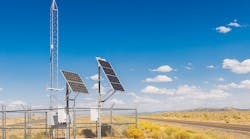5 Major Benefits of a New Energy Paradigm for the ICT Sector
By 2017, Internet traffic is expected to be a whopping 85 times higher than it was 5 short years ago. All that data flow has big implications for carriers. They need to handle more information than ever before, and deliver connectivity to customers with near-flawless 24/7 uptime. Achieving that high benchmark requires rethinking how we power the network.
Cloud services and applications that provide users around the globe with on-demand computing, storage, and software services, are also playing a big part here. Whether you’re on the subway or miles high in the sky, the power to be connected at all times is taking a toll on our infrastructure.
In addition to policy- and regulatory-driven shifts (e.g., the COP21 climate accord), a growing wave of companies are leading the charge for energy solutions and renewable energy generation, all of which reduce the reliance on fossil fuels and meet the growing customer demand for a cleaner energy portfolio.
Current static energy technology and infrastructure intended for a specific function is being replaced by dynamic energy solutions that can perform useful work while delivering cost savings and increased performance.
5 Major Benefits
The energy solutions when structured as a service (EaaS) include 5 major benefits for the ICT sector:
1. Enables wireless carriers to focus on their core business, not energy.
Wireless carriers are in the business of providing network connectivity, not generating and managing energy. Shifting from traditional static power infrastructure to EaaS allows them to focus on their core business, leaving the energy in the capable hands of a trusted partner.
Systems are moving away from the traditional combination of lead-acid batteries and diesel generation in favor of powerful lithium-ion battery energy storage and solar PV energy generation. Systems leverage remote and site-installed hardware and software to communicate with and intelligently operate on-site assets (battery, generator, HVAC, etc.) from the network operations center.
2. EaaS replaces traditional CapEx with predictable, stable OpEx.
These significant performance enhancements and operational savings are enabling EaaS to pay for itself, requiring virtually no capital outlay to the carrier or network operator. They are changing the way wireless carriers spend on energy, taking something that’s historically a capital expenditure and turning it into an operating expense. This helps wireless carriers avoid large volatility in capital spending as equipment wears out and has to be replaced.
3. Unlocks energy cost savings.
Modern EaaS solutions allow carriers to intelligently manage a site’s services and assets, extending their useful life and enabling customers to lower operating costs, 10%-15% of which are associated with energy infrastructure and services.
In certain markets, the solution even offers an opportunity for smart grid energy arbitrage. Smart software algorithms manage on-site generation and storage in concert with grid electricity prices to optimize and reduce energy costs without sacrificing service. Grid-connected sites can even provide services back to the grid, such as frequency regulation, generating a revenue stream that further improves the economics.
4. Provides reliable power (primary and/or backup).
The robust nature of this type of architecture opens doors for on-grid, off-grid, and unreliable-grid applications for cell sites of all sizes, supplying primary and/or backup power that operators can count on. They even provide configurable size and weight advantages for deployment at restricted sites, including rooftops.
The new wave of comprehensive solutions provide ICT providers a sense of assurance. They offer remote monitoring and maintenance, and can take responsibility for the grid power, any renewable power onsite, and all of the energy infrastructure at the tower, even when traditional energy sources fail.
5. Dramatic improvements in environmental footprint.
As these new technologies transition to the use of clean renewable energy in lieu of diesel generators and toxic lead acid batteries, network operators are drastically reducing the environmental footprint of their towers. With EaaS solutions in place, greener and safer communities are born.
So where is all of this taking place? These innovative, renewable energy solutions are evolving in North America first, but are expected to emerge across the globe.
Interested in learning more about Energy Solutions and Energy-as-a-Service financial structures? Visit business.panasonic.com/solutions-energysolutions-information-communication-technologies.





